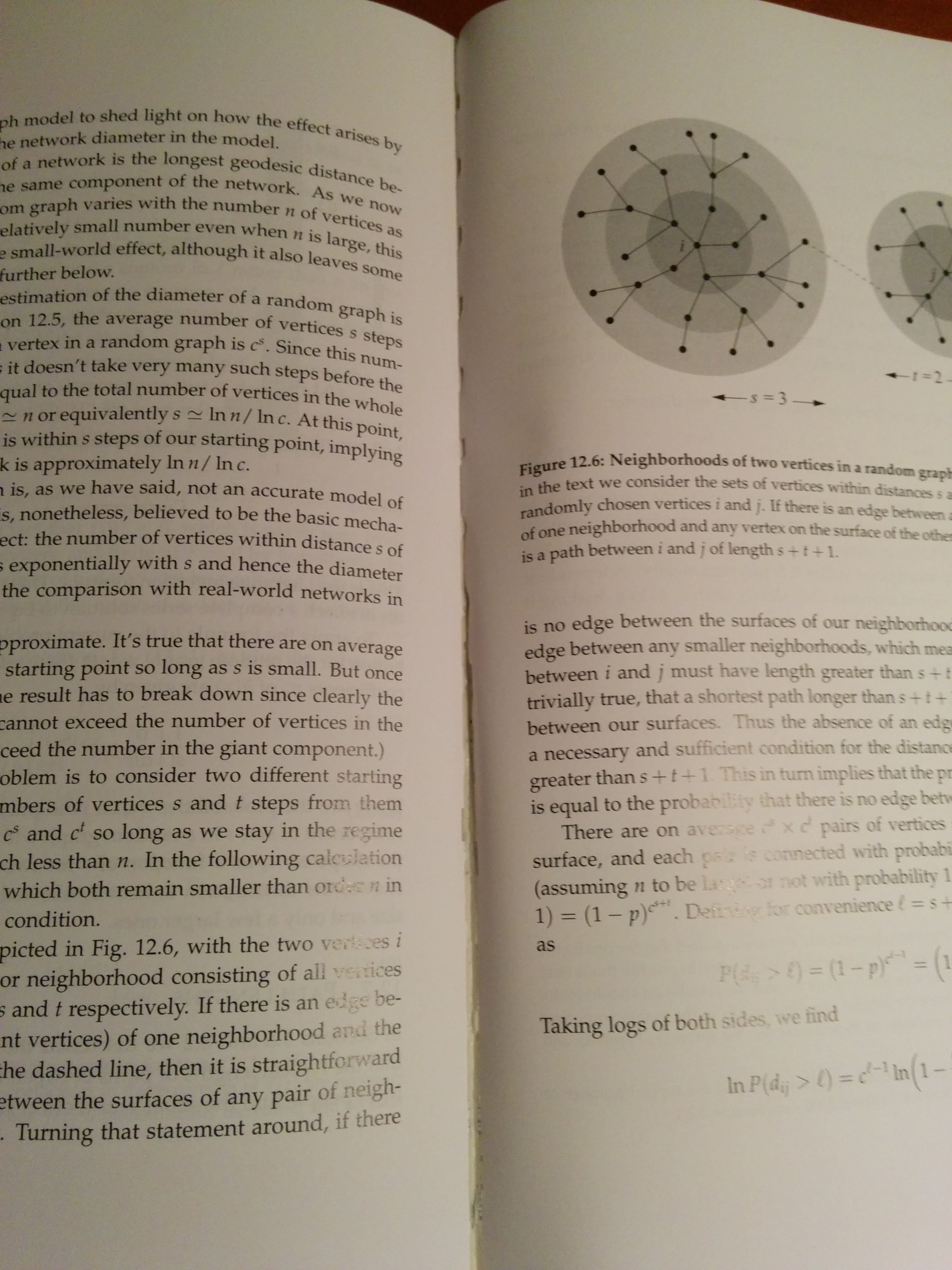





Networks: An Introduction
K**N
wonderful book on networks
If you are a layman of network study and want to learn about it in a quantitative way, this is a wonderful book to start from. If you do work on networks, you probably already have this book, for it serves as an excellent reference too. This book gives a comprehensive and rigorous introduction to the core concepts of networks (vertex, edge, degree, centrality, component, path, etc.) and classical algorithms to do computations. Prof. Newman's writing style is extremely clear. There are no logic gaps between sentences. Whenever you find something unclear or confusing during reading, you will find an explanation in the following paragraphs.
C**G
Great Introduction to the Networks
It's a great guide to the math for understanding the networks and probably the first book which covers from the basic stuff to the profound analysis, whereas the other books on networks handle very complex math and some pure physical models.But the each chapter of this book doesn't delve into the deep side of the topic. I think of that this book is written by the author's students.And the bookbinding by Oxford press is very disappointed for me.Although those, the content of this book is very useful for person who is trying to step into the networks technology.GREAT!
A**R
An important book in networks, but if you are unfamiliar with the subject beware
I purchased this book for a network graduate class I was taking. While this is one of the seminal books on the subject, it is complicated and often does not explain the math very well. It also covers a wide range of networks, from social networks to biological networks. This makes it good for showing how networks can be used, but does not delve deep enough into any one of them to make you feel really comfortable with any one type.
C**L
Accessible, relevant and comprehensive introduction
I use network analysis in ecological research. I have found most reference books either highly technical or so simplistic as to be of of little use. This new book is the exception. It is quite well-written, and covers much recent applied research that uses network theory, as well as the analytical and computational background behind these applications. As well as being a good textbook, it is a great introduction to the topic for quantitative researchers in other fields that wish to apply network analysis to their work, and because it is up-to-date, I will continue to use it as a reference in the future.
F**N
Broad, deep and a joy to read.
The book really is an excellent guide to the vast domain of graphs and diagramming. It covers many topics and applications while remaining very readable despite the fact that it discusses various technical topics. I'd say it's an excellent bridge between the domain from a mathematical point of view and from an applicative angle.If you need a gateway to this domain and a have an undergraduate understanding of maths then this book is for you.[Things I wished would have been highlighted; the relation to knots and an introduction to graph layout algorithms.]
A**B
A great introduction to Network Science
A great introduction to Network Science. I found the later chapters on dynamics in networks and computer algorithms for networks to be invaluable. Many books (especially in social sciences) are content to use the language of networks without exploring the mathematics behind it. This book does not shy away from the math, but keeps it understandable.
L**W
Decent, but not the best text I've read.
The explanations of network concepts were basic and easy to understand. This was a good introduction to the ideas. Whether it's better than what you could get with a brief literature review, I'm not sure, but they're all assembled together and that's worth quite a bit. But this book bit off a bit more than it could chew. A five chapter section is dedicated to applications, and another section is dedicated to methods, but it's neither a great survey nor methods text.Network analysis spans a wide range of fields, so this must have been an especially difficult book to write. But I felt that it overgeneralized and mis-characterize a bit too much in the occasional area where I was familiar, which made me hesitant to trust it as an accurate representation of areas for which I was less familiar. If they had just been illustrative examples I wouldn't have let it affect the review, but there were five chapters dedicated to applications on different fields, and the introduction recommended using those chapters for introductory classes. Since I'm not confident they provide accurate representations of network analysis in those fields, I knocked a star.I knocked a second star because it's not the greatest introduction to the math. The math is relatively simple, but since it is a text book, you expect to be walked through it a bit better, maybe provide exercises or examples. The book is trying to be everything for everyone and ends up not managing to be the best at anything. It isn't a great methods text, it doesn't walk you through the math and how to apply it, and it isn't a compelling overview of the applications. It ends up being half-way for both. So, decent, but not the best. If anyone has any alternative recommendations, please post in the comments.
W**G
poor kindle version
The content of the book is excellent and is worth 5 stars, but the kindle version is quite poor. For some reason, in the kindle version, the formulas are so small that they are barely readable. How disappointing! The publisher should seriously consider adjusting the formulas.By the way, the index does not work: the phrases in the index sections are not links and they don't come with page number. They are just words.
L**R
Great
Wonderful book...
C**A
Che dire
Una bibbia per la teoria della reti. Insieme al Barabasi è un must. È forse più metodico e rigoroso, come testo introduttivo non sbaglia una virgola :)
S**I
Sehr gut
Hervorragende Einführung. Sehr gut geschrieben, deutlich strukturiert und verständlich. Hilfreiche Darstellungen, passendes Format, um das Lernen zu vereinfachen. Mark Newman ist eine Kapazität in der Materie, versucht aber nie zu beeindrucken, sondern stets die Materie beizubringen - und dann verweist er auf die richtige Literatur. Das Beibringen gelingt ihm auf eine Art und Weise, die täuschend mühelos wirkt. Mit dieser sehr umfangreichen und multidisziplinären Thematik ist äußerst schwer alle Fachrichtungen gleich zu befriedigen. Zum Beispiel hätte ich mir mehr Seiten zu direkten und assoziativen Netzwerken und zu Hubs gewünscht, denn all dies kommt im Finanzsystem sehr oft vor. Doch finde ich, dass Mark Newman viel Rücksicht auf eine breite Palette von Disziplinen gehabt, und nicht nur auf die relevantesten Aspekte fürs Fach Physik - sein Fach - fokussiert hat. Eine kleine Bemerkung zum Schluss: Das Buch hätte etwas günstiger sein können - aber den Preis nehme ich gerne in Kauf, wenn ich bedenke, wie viel Spaß das Buch mir schon bereitet hat!
C**L
el libro de redes
hay otros como el de crowds and markets pero este, si bine es más duro, es más científico. Con él se puede tirar del hilo para saber bastante. hace falta cierto nivel matemático
O**.
The best book to start with networks and beyond
Mark Newman's "Networks: An Introduction" is the single book that one needs in order to start his or her (postgraduate) research on networks. The book explains thoroughly and from first (mathematical) principles all the aspects of networks that a researcher needs to know: from structural properties and computer algorithms to network generation models and dynamical processes on networks. After reading this book, all the vast bibliography on networks will become accessible to the reader. This book is not an easy read, and requires a good level of mathematical understanding, but it is certainly one of the most rewarding books I have ever read. Finally, to put this review in context, at the time of writing I am a first-year PhD student in Computer Science.
Trustpilot
2 weeks ago
1 month ago